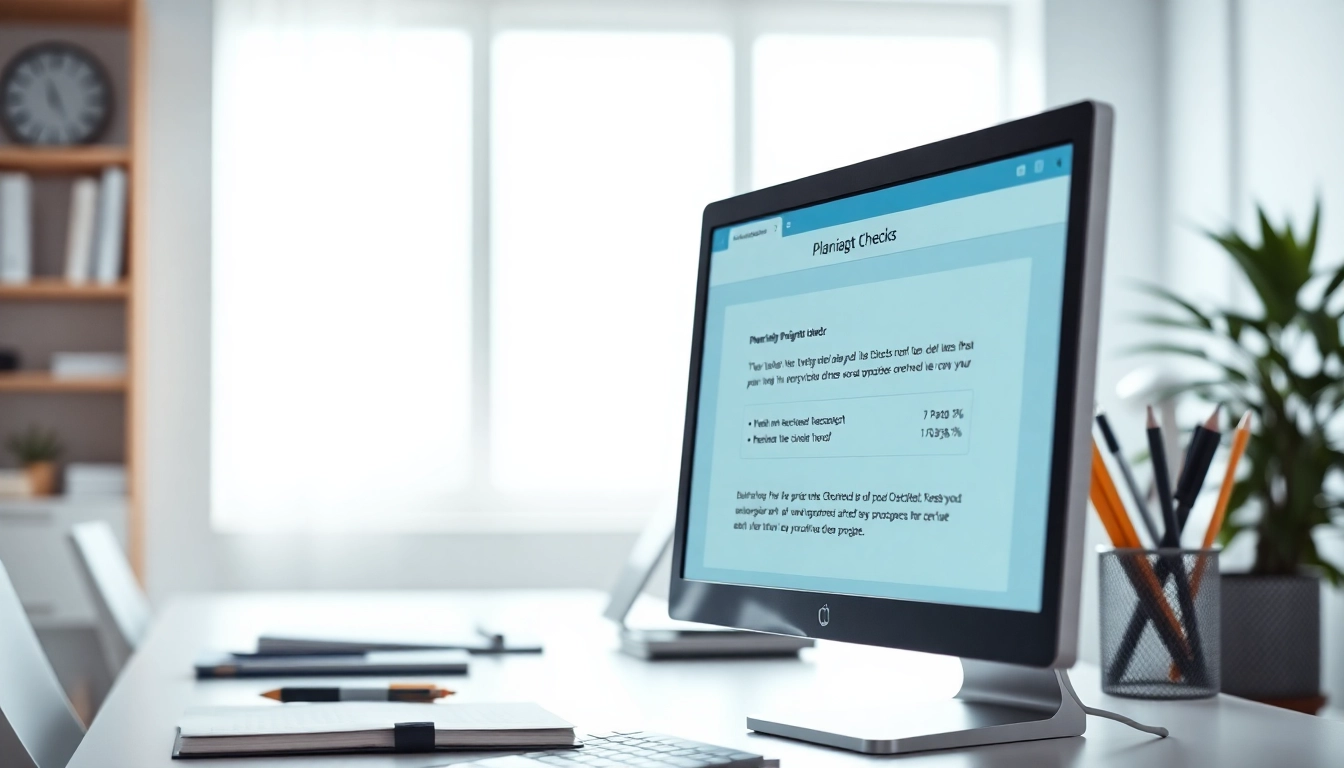Understanding the Importance of a Plagiarism Checker
In an age where information is at our fingertips, ensuring the originality of written content has become essential, particularly in academic and professional settings. A plagiarism checker plays a critical role in maintaining the integrity of writing by detecting instances of copied text and providing insights to help writers improve their work. In this article, we will delve into the significance of plagiarism checkers, how to choose the right one, and integrate this tool effectively into your writing process.
What is a Plagiarism Checker?
A plagiarism checker is an online tool that scans texts for potential instances of plagiarism by comparing the content against a vast database of online and offline sources. These tools are designed to identify similarities in the text and highlight potential instances of copied material, helping users take necessary actions to ensure originality. Most plagiarism checkers utilize algorithms and AI technology to evaluate text quickly and accurately, providing users with detailed reports that include originality percentages and links to the sources that have been matched.
Why Academic Integrity Matters
Academic integrity is a cornerstone of educational systems, fostering an environment where knowledge is shared responsibly and ethically. Violations of this principle, such as plagiarism, can lead to severe consequences, including revoked degrees, damaged reputations, and significant academic penalties. Institutions that prioritize academic integrity encourage students and faculty to produce authentic work, contributing to a culture of trust and accountability. Utilizing a plagiarism checker not only helps verify the originality of a document but also educates users on proper citation practices and the importance of crediting original authors.
Common Misconceptions About Plagiarism
Plagiarism is often misunderstood, leading to confusion among students and writers alike. Here are a few common misconceptions:
- Only verbatim copying constitutes plagiarism: Many individuals believe that unless they copy text word-for-word, they are not plagiarizing. However, paraphrasing someone else’s ideas without proper attribution also qualifies as plagiarism.
- Plagiarism is only a concern for students: While students are frequently warned against plagiarism, professionals and academics must also remain vigilant. Originality is critical in research, publications, and presentations across various fields.
- Plagiarism checkers are foolproof: Although these tools are beneficial in identifying potential plagiarism, they are not infallible. Users must still exercise critical judgment and examine the flagged sections to confirm whether they indeed require citation or rephrasing.
How to Choose the Right Plagiarism Checker
With numerous plagiarism checkers available online, choosing the right one can be daunting. Below are some factors to consider when selecting a tool that suits your needs.
Key Features to Look For
When evaluating plagiarism checkers, consider the following features:
- Comprehensive Database: A good plagiarism checker should compare your text against a wide-ranging database, including academic journals, online publications, and student papers.
- Detailed Reports: Look for tools that provide in-depth reports, highlighting problematic sections and suggesting ways to address them.
- User-Friendly Interface: The tool should be easy to navigate, allowing you to upload documents quickly and access results with minimal effort.
- Integration Capabilities: Many writers prefer tools that can be integrated into their existing workflows, such as word processors or document management systems.
Comparing Free vs. Paid Plagiarism Checkers
Free plagiarism checkers offer an accessible way for users to examine their work for originality, but they often come with limitations regarding the comprehensiveness of the database and the features available. On the other hand, paid plagiarism checkers typically provide access to a more extensive database, advanced reporting features, and sometimes offer customer support for users. Ultimately, the choice between a free or paid tool should be guided by your needs, the nature of your writing, and whether the additional reliability of paid services is worth the investment.
Reading User Reviews and Ratings
User reviews and ratings are invaluable in evaluating the effectiveness and reliability of plagiarism checkers. Checking independent forums or review websites can offer insights about the user experience, functionality, and accuracy of different tools. Pay attention to recurring themes in feedback, which can help highlight strengths and areas for improvement of various plagiarism checkers.
Steps to Using a Plagiarism Checker Effectively
Using a plagiarism checker is straightforward, but certain steps can help maximize its effectiveness in ensuring the originality of your text.
Preparing Your Document for Checking
Before submitting your document to a plagiarism checker, ensure it is correctly formatted and complete. This preparation stage might include:
- Checking the document for grammar and spelling errors.
- Ensuring all references are correctly formatted and placed.
- Using a clear and concise structure that accurately represents your argument or narrative.
Interpreting the Results
Once you receive the results from the plagiarism checker, take the time to review the findings thoroughly. Pay attention to:
- Percentage of Plagiarism: A higher percentage may indicate significant portions of your text are not original, which warrants attention.
- Highlighted Sections: These are the excerpts flagged for potential plagiarism. Review them closely to determine if they need to be revised or cited properly.
- Source Links: Most plagiarism checkers provide links to the sources identified in the check. Evaluating these sources can offer insights into how to restructure sentences or arguments differently.
How to Address Identified Issues
After identifying issues of plagiarism, it is important to take corrective action. Depending on the results, options may include:
- Rewriting Sections: Paraphrasing or rewording flagged text to present the ideas in your own voice is a respectful way to retain the essence while avoiding plagiarism.
- Citing Sources: If you reference ideas or quotes from other authors, ensure that you give full credit by properly citing the sources in your work.
- Seeking Professional Help: If confronted with significant issues, consider consulting writing professionals or academic advisors for assistance.
Integrating Plagiarism Checkers into Your Writing Workflow
Incorporating plagiarism checkers into your writing process can enhance your productivity and ensure the integrity of your work. Here are some best practices to do so effectively:
Best Practices for Students
As students navigate through coursework and research projects, integrating plagiarism checkers can support their academic efforts. Consider the following approaches:
- Use plagiarism checkers early in the writing process to avoid potential pitfalls before finalizing drafts.
- Engage with these tools to learn about proper citation practices, improving overall writing quality.
- Utilize feedback from plagiarism reports to enhance critical thinking and writing skills.
Utilizing Checkers in Professional Writing
For professionals crafting articles, reports, or presentations, plagiarism checkers can ensure the credibility and originality of the content. Strategies include:
- Implementing plagiarism checks as part of the editorial process, especially when collaborating with multiple authors.
- Utilizing results to create clearer connections among ideas and enhance the organization’s messaging.
- Fostering a culture that promotes originality and ethical writing practices among team members.
Creating a Culture of Originality
Acknowledging the value of originality in writing influences both individuals and organizations. To nurture a culture of authenticity, consider the following:
- Encouraging open discussions about writing ethics and the importance of plagiarism prevention.
- Providing regular training sessions or workshops on effective writing and research techniques.
- Recognizing and rewarding original contributions in academic and professional settings, enhancing motivation for individuals to produce authentic work.
The Impact of Plagiarism Checkers on Academic Success
The benefits of using plagiarism checkers extend beyond mere avoidance of academic penalties; they can significantly influence overall academic success.
Improving Writing Skills Over Time
By regularly utilizing plagiarism checkers, individuals can enhance their writing skills. As users engage with feedback and flagged content, they learn to be more cognizant of their writing and crediting sources properly. This continuous learning process can lead to improved academic performance and better writing in other professional contexts.
Building Trust with Instructors
For students, consistent use of plagiarism checkers reinforces trust between them and their instructors. Demonstrating a commitment to original work can foster positive relationships, which may lead to greater academic support and mentorship opportunities.
Long-term Benefits of Using Plagiarism Checkers
The long-term impact of routinely leveraging plagiarism checkers is profound. Besides enhancing one’s reputation as a credible writer, these tools can instill a deep-rooted respect for intellectual property and ethical writing. This respect extends to future career opportunities, where originality and honesty are cornerstones of professional integrity.
In conclusion, a plagiarism checker represents a vital tool in today’s academic and professional environments, supporting the creation of original and credible content. By understanding its significance, learning to choose the right tool, effectively using it, and promoting a culture of originality, individuals can transform their writing practices for the better.















Leave a Reply